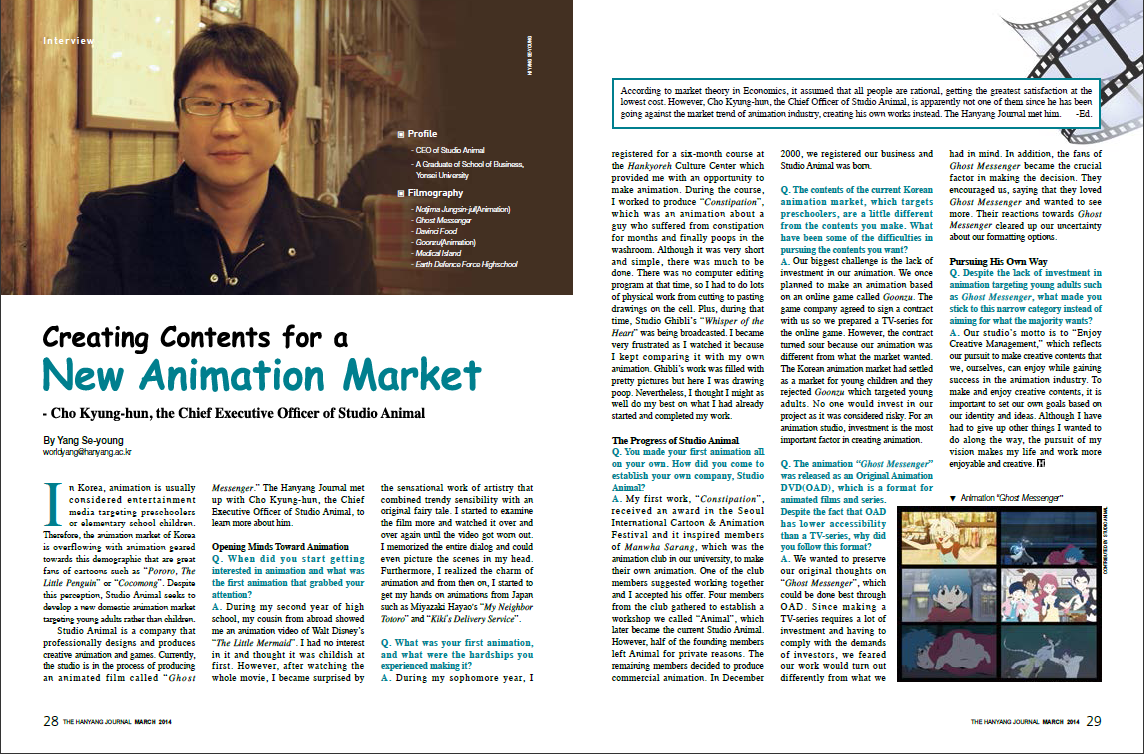
Studio Animal is a company that professionally designs and produces creative animation and games. Currently, the studio is in the process of producing an animated film called "Ghost Messenger." The Hanyang Journal met up with Cho Kyung-hun, the Chief Executive Officer of Studio Animal, to learn more about him.
Opening Minds toward Animation
Q. When did you start getting interested in animation and what was the first animation that grabbed your attention?
A. During my second year of high school, my cousin from abroad showed me a video of Walt Disney’s “The Little Mermaid”. I did not like it that much and thought it was childish at first. However, after watching the whole movie, I became surprised by the sensational work of artistry that combined trendy sensibility with an original fairy tale. I started to examine the film more and watched it over and over again until the video got worn out. I memorized the entire dialog and could even picture the scenes in my head. Furthermore, I realized the charm of animation and from then, I started to get my hands on as much animation from Japan that I could, such as Miyazaki Hayao's “My Neighbor Totoro” and “Kiki's Delivery Service”.
Q. What was your first animation, and what were the hardships you experienced making it?
A. During my sophomore year, I registered for a six-month course in at the Hankyoreh Culture Center which provided me with an opportunity to make animation. During the course, I worked to produce “Constipation”, which was an animation about a guy who suffered from constipation for months and finally poops in the washroom. Although it was very short and simple, there was much to be done. There was no computer editing program at that time, so I had to do lots of physical work from cutting to pasting drawings on the cell. Plus, during that time, Studio Ghibli’s “Whisper of the Heart” was being broadcast. I became very frustrated as I watched it because I kept comparing it with my own animation. Ghibli’s work was filled with pretty pictures but here I was drawing poop. Nevertheless, I thought I might as well do my best on what I had already started and completed my work.
The Progress of Studio Animal
Q. You made your first animation all on your own. How did you come to establish your own company, Studio Animal?
A. My first work, "Constipation", received an award in the Seoul International Cartoon & Animation Festival and it inspired members of Manwha Sarang which is the animation club in our university, to make their own animation. One of the club members suggested working together and I accepted his offer. Four members from the club gathered to establish a workshop we called “Animal”, which later became the current Studio Animal. However, half of the founding members left Animal for private reasons. The remaining members decided to produce commercial animation. In December 2000, we registered our business and Studio Animal was born.
Q. The contents of the current Korean animation market, which targets preschoolers, are a little different from the contents you make. What have been some of the difficulties in pursuing the contents you want?
A. Our biggest challenge is the lack of investment in our animation. We once planned to make an animation based on an online game called Goonzu.. The game company agreed to sign a contract with us so we prepared a TV-series for the online game. However, the contract turned sour because our animation was different from what the market wanted. The Korean animation market had settled as a market for young children and they rejected Goonzu which targeted adults. No one would invest in our project as it was considered risky. For an animation studio, investment is the most important factor in creating animation.
Q. The animation “Ghost Messenger” was released as an Original Animation DVD(OAD), which is a format for animated films and series. Despite the fact that OAD has lower accessibility than a TV-series, why did you follow this format?
A. We wanted to preserve our original thoughts on “Ghost Messenger”, which could be done best through OAD. Since making a TV-series requires a lot of investment and having to comply with the demands of investors, we feared our work would turn out differently from what we had in mind. In addition, the fans of Ghost Messenger became the crucial factor in making the decision. They encouraged us, saying that they loved Ghost Messenger and wanted to see more. Their reactions towards Ghost Messenger cleared up our uncertainty about our formatting options.
Pursuing His Own Way
Q. Despite the lack of investment in animation targeting young adults such as Ghost Messenger, what made you stick to this narrow category instead of aiming for what the majority wants?
A. Our studio’s motto is to “Enjoy Creative Management,” which reflects our pursuit to make creative contents that we, ourselves, can enjoy while gaining success in the animation industry. We have tried to make creative animation even though it is not mainstream in the Korean animation market. To make and enjoy creative contents, it is important to set our own goals based on our identity and ideas, not only on current trends. Although I have had to give up other things I wanted to do along the way, the pursuit of my vision makes my life and work more enjoyable and creative.

